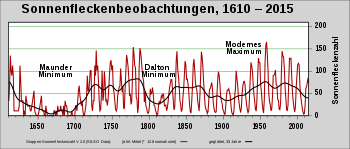Maunder minimum

A period of greatly reduced sunspot activity between 1645 and 1715 is called the Maunder Minimum .
Climatological classification

The Maunder Minimum (named after Edward Walter Maunder ) fell during a particularly cool period of the middle Little Ice Age in the Earth's northern hemisphere. However, temperatures began to drop well before the start of the Maunder minimum. In addition to other factors, such as volcanic activity, the long-term cooling trend caused by changes in the earth's orbit around the sun , or changes in land use, the reduced solar intensity may have temporarily contributed to the Little Ice Age. Many very cold winters occurred in Europe , North America, and China during the Little Ice Age (records from other parts of the world are not detailed enough to generalize this statement).
The Maunder minimum was preceded by the Wolf minimum around 1300 (according to R. Wolf ) and the Spörer minimum in the 15th century. This was followed by the Dalton minimum 1790-1820, which marked the end of the Little Ice Age. There are indications that the modern maximum (1950–2009, with its peak around 1960) is transitioning into a new minimum. According to various studies, it would lower global temperatures slightly - according to best estimates by less than 0.1 ° C - and thus hardly attenuate the current global warming , which is mainly caused by greenhouse gas emissions .
Research history
The American astronomer John A. ("Jack") Eddy (1931–2009) researched the phase in 1976 and named it after the English astronomer Annie Maunder and her husband EW Maunder , who later recognized the low number of sunspots of that period. Sunspots had only been systematically observed shortly before the Maunder Minimum, so that at that time no expectations could be made regarding their frequency; only in retrospect could it be seen that the situation since 1715 differs significantly from that between 1645 and 1715.
The decreased sunspot activity was accompanied by a decreased radiation intensity. Hence the idea that this astronomical event had an impact on the climatology of the earth soon came up.
However, this effect alone is too small and the Maunder Minimum set in too late to fully explain the Little Ice Age. With the help of a coupled climate model, it was simulated what influence a solar minimum at the height of the Maunder minimum would have in the future. With a sun of this magnitude weaker, the global average temperature would probably be about 0.1 degrees lower than with normal solar activity. The human influences on the earth's climate are therefore likely to be much stronger.
At the 24th General Assembly of the International Astronomical Union in 2015, a revised series of data from 1750 was presented after the observation conditions were checked again, which now results in less low and higher sunspot numbers around 1885 and 1945. This means that the Maunder minimum is also less extreme in the time series.
literature
- Klaus G. Strassmeier: Active Stars. Solar Astrophysics Laboratories. Vienna / New York 1997, p. 26, 169 ff.
- Willie Wei-Hock Soon , Steven H. Yaskell: The Maunder Minimum and the Variable Sun-Earth Connection. World Scientific, 2003, ISBN 981-238-274-7 .
- NASA Earth Observatory (2006): Chilly Temperatures During the Maunder Minimum. ( Online , accessed Sept. 21, 2016)
Web links
- Graphs demonstrating improved agreement between Old and New Sunspot Numbers and The Newly Calibrated sunspot Group Number over the last 400 years (iau.org, August 2025, to press release iau1508)
Individual evidence
- ↑ a b c Corrected Sunspot History Suggests Climate Change since the Industrial Revolution not due to Natural Solar Trends. International Astronomical Union press release, iau1508, August 7, 2015 (iau.org, accessed August 20, 2015).
- ↑ a b Mathew J. Owens, Mike Lockwood, Ed Hawkins, Ilya Usoskin, Gareth P. Jones, Luke Barnard, Andrew Schurer, John Fasullo: The Maunder Minimum and the Little Ice Age to update from recent reconstructions and climate simulations . In: Journal of Space Weather and Space Climate . tape 7 , A33, 2017, doi : 10.1051 / swsc / 2017034 (English).
- ↑ G. Usoskin et al. a .: Evidence for distinct modes of solar activity . In: Astronomy & Astrophysics . 2014, doi : 10.1051 / 0004-6361 / 201423391 (English).
- ↑ Sarah Ineson et al. a .: Regional climate impacts of a possible future grand solar minimum . In: Nature Communications . June 23, 2015, doi : 10.1038 / ncomms8535 (English).
- ↑ a b Georg Feulner, Stefan Rahmstorf : On the effect of a new grand minimum of solar activity on the future climate on Earth . In: Geophysical Research Letters . March 2010, doi : 10.1029 / 2010GL042710 (English).
- ^ Gareth S. Jones, Mike Lockwood, Peter A. Stott: What influence will future solar activity changes over the 21st century have on projected global near-surface temperature changes? In: Journal of Geophysical Research . March 2012, doi : 10.1029 / 2011JD017013 (English).
- ^ John A. Eddy, Solar Detective, Dies at 78 . In: NY Times online, June 17, 2009.
- ↑ John A. Eddy: The Maunder Minimum . In: Science . 192, No. 4245, June 1976, pp. 1189-1202. bibcode : 1976Sci ... 192.1189E . doi : 10.1126 / science.192.4245.1189 . PMID 17771739 . http://bill.srnr.arizona.edu/classes/182h/Climate/Solar/Maunder%20Minimum.pdf PDF Copy http://www.sciencemag.org/cgi/content/citation/192/4245/1189 ( Memento from February 16, 2010)
- ↑ There is some controversy about the age of the name, and about whether Eddy made or adopted the name, see Who named the Maunder Minimum? Blog post, July 6, 2009.